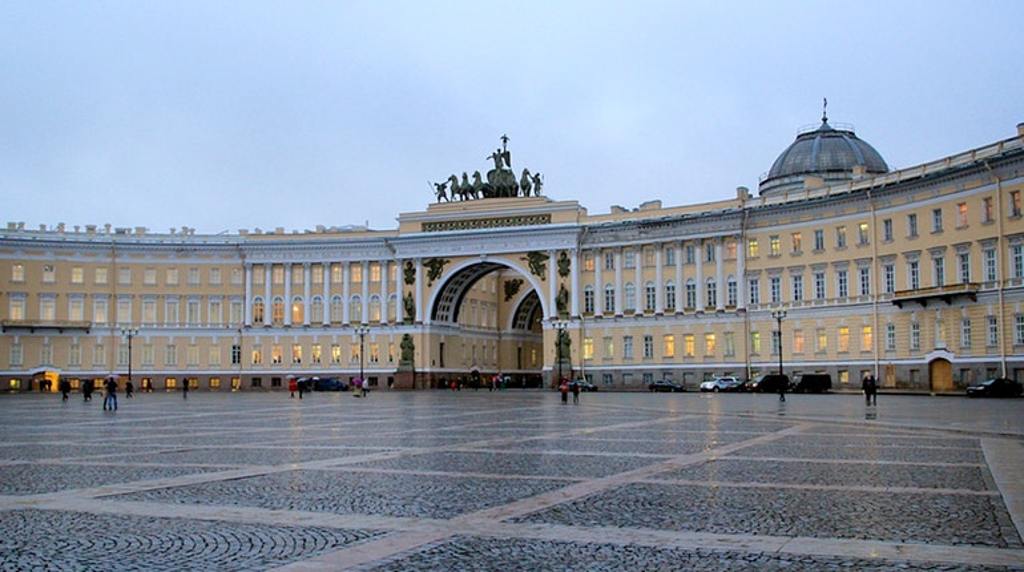General Staff Building St Petersburg, is part of the Hermitage Museum, so if you decide to visit the Hermitage, make sure you don’t miss this part too. Here you will see the Impressionist and Post-Impressionist paintings. It can easily be spotted and it is the majestic yellow structure which consists of the two wings connected with the arch. It is located just opposite the Winter Palace across the Palace Square in the Eastern wing. The entrance is to the left of the archway on the inside of the curve. The General Staff Building St Petersburg dates back to 1820 – 1830 as a governmental building to house various ministries of Imperial Russia, such as the Ministry of Finance, Ministry of Foreign Affairs and others. This huge building which its perimeter is approximately 500 m, was designed by the famous Italian architect Carlo Rossi, the one who created many outstanding buildings, palaces and squares in St-Petersburg.
General Staff Building St Petersburg
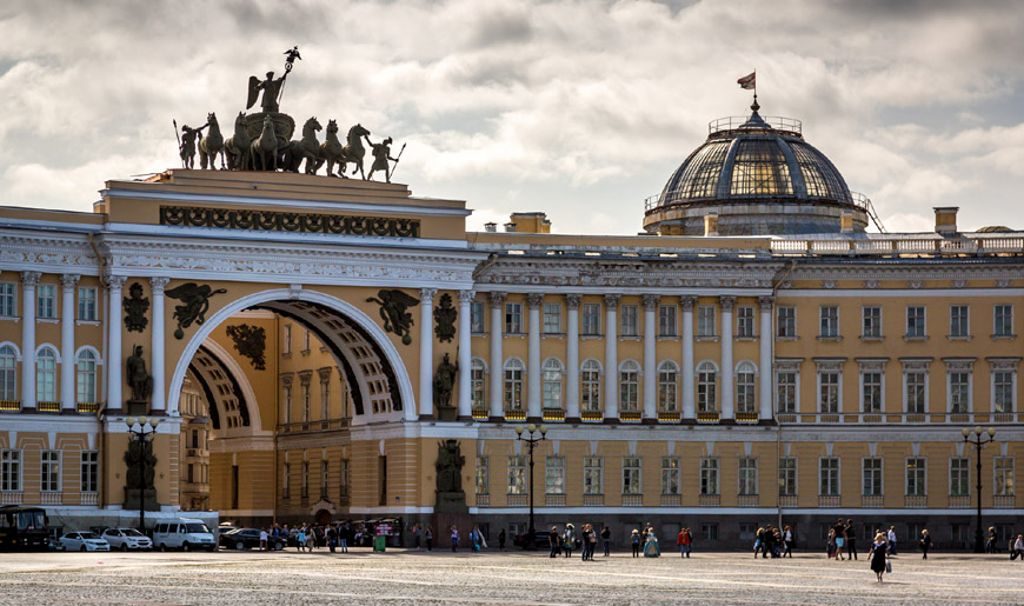 The double arch that connects the two wings of the General Building St Petersburg, is crowned by a chariot of Glory in memory of Russia’s victory over Napoleonic France back in 1812.
The double arch that connects the two wings of the General Building St Petersburg, is crowned by a chariot of Glory in memory of Russia’s victory over Napoleonic France back in 1812.
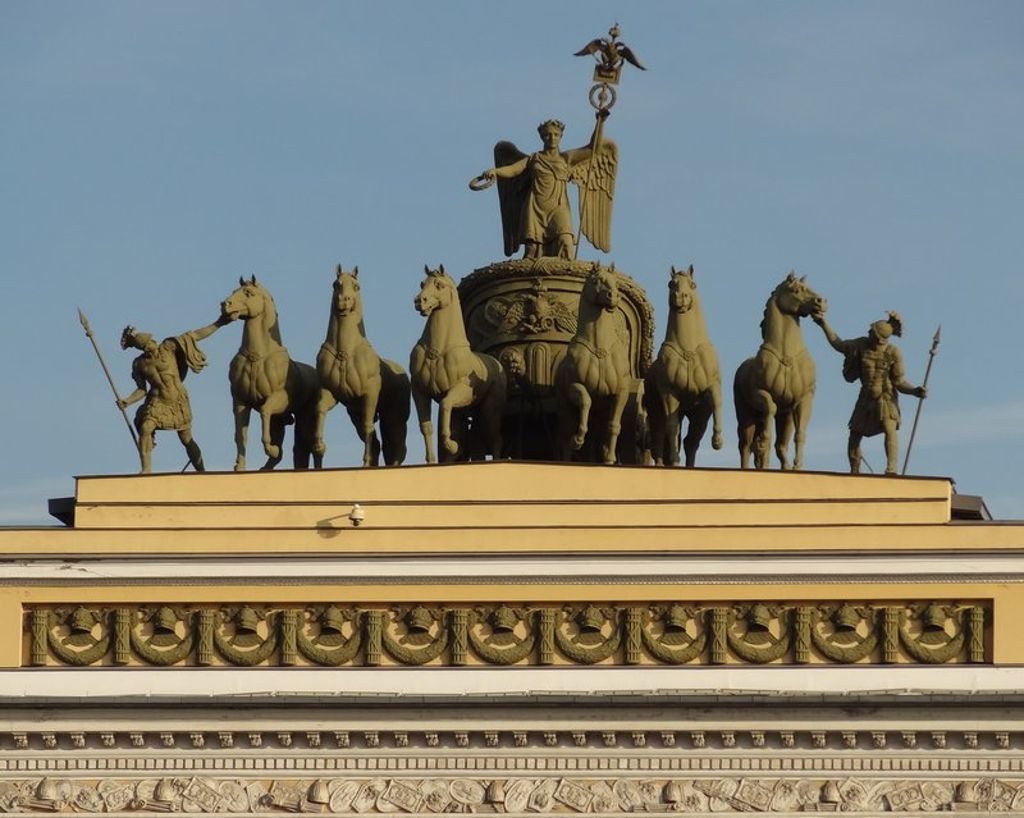 Lower floors are huge but mostly empty with almost nothing on the walls, and they lead out onto another-worldly space linked by a bridge.
Lower floors are huge but mostly empty with almost nothing on the walls, and they lead out onto another-worldly space linked by a bridge.
General Staff Building St Petersburg
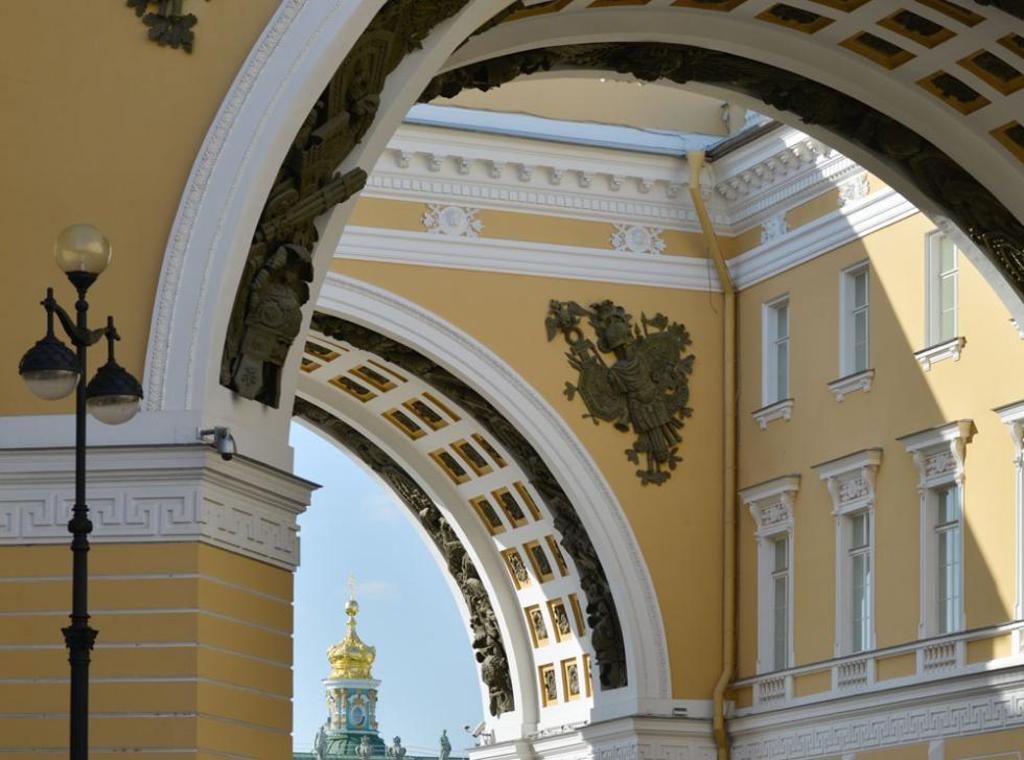 After the Revolution of 1917, the Eastern wing was occupied by different institutions and organizations until 1988 when it was finally handed over to the Hermitage Museum. There were several, rather interesting exhibitions opened when the building was opened to visitors. One of which was the Museum of the guard, an Empire style exhibition in the former headquarters of the Ministry of Foreign Affairs. It was not until 2014 when the entire building was properly restored.
After the Revolution of 1917, the Eastern wing was occupied by different institutions and organizations until 1988 when it was finally handed over to the Hermitage Museum. There were several, rather interesting exhibitions opened when the building was opened to visitors. One of which was the Museum of the guard, an Empire style exhibition in the former headquarters of the Ministry of Foreign Affairs. It was not until 2014 when the entire building was properly restored.
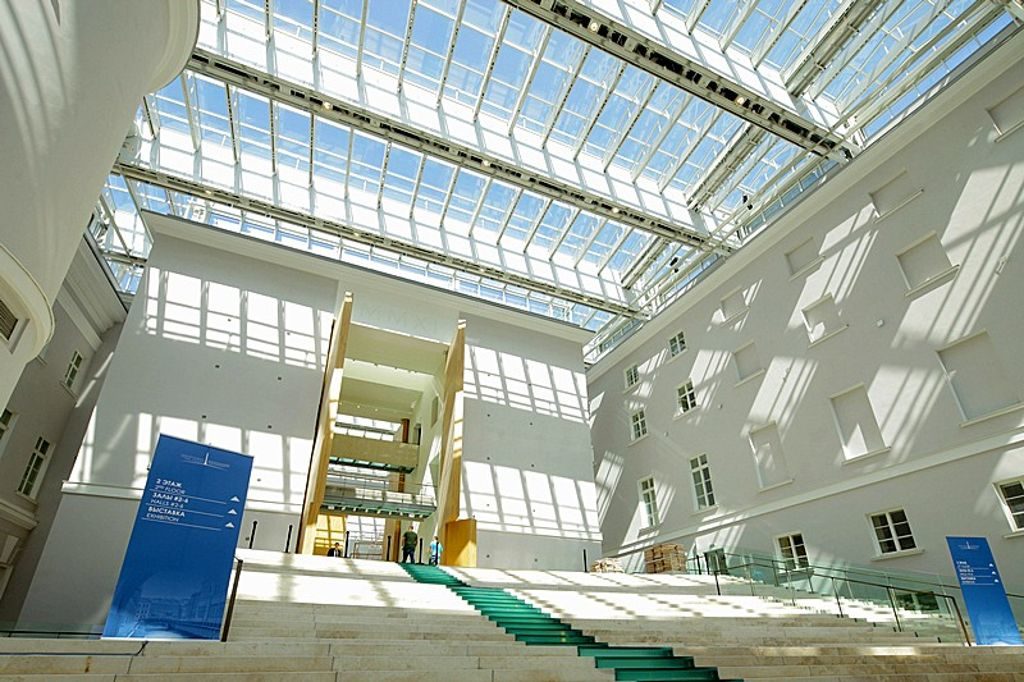 In 2014 they celebrated the 250th anniversary of the foundation of the Hermitage Museum, and that same year the eastern wing of the General Staff Building opened the doors to visitors. By the way, the year of the Hermitage foundation is considered the year (1764) when the Empress Catherine the Great purchased her first collection of art.
In 2014 they celebrated the 250th anniversary of the foundation of the Hermitage Museum, and that same year the eastern wing of the General Staff Building opened the doors to visitors. By the way, the year of the Hermitage foundation is considered the year (1764) when the Empress Catherine the Great purchased her first collection of art.
A glass roof was added to cover five big atriums, so the former outdoor territory was turned into an additional museum space. The new Big Enfilade is a series of three large halls arranged in an enfilade along the palace’s massive facade facing the River Neva. Temporary exhibitions are regularly held in the rooms, making it the main venue for contemporary art display.
General Staff Building St Petersburg
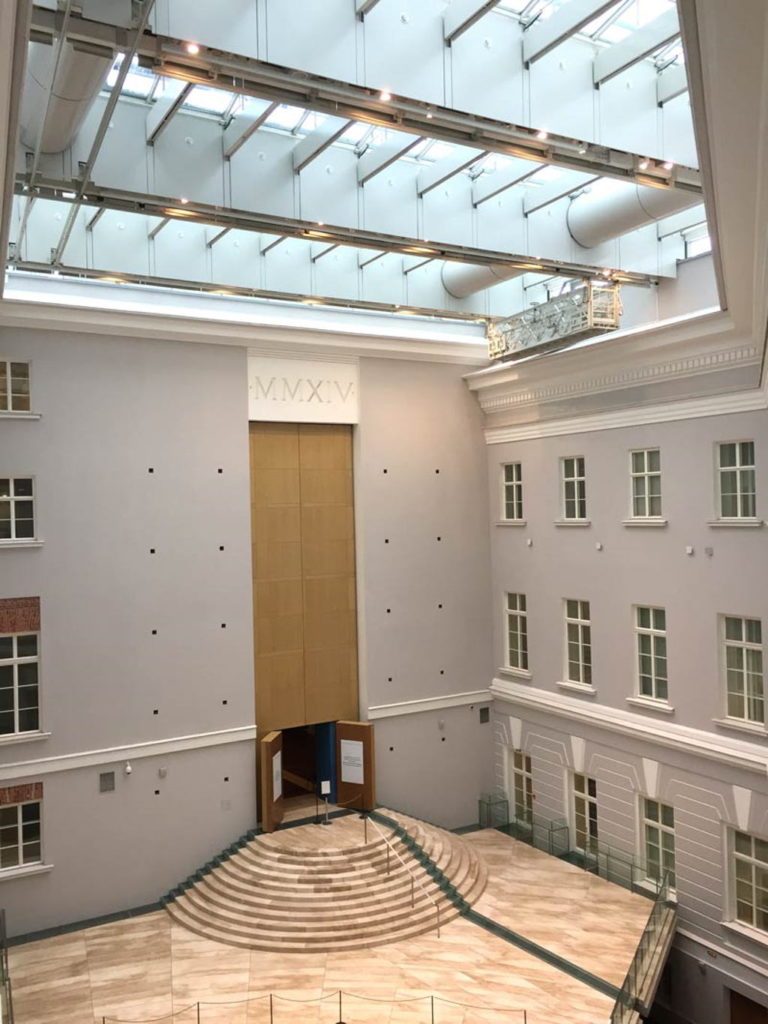 Upon entering the Eastern Wing of the General Staff Building, you’ll be impressed first of all by the lack of crowds of people. A very different picture, unlike inside in the Winter Palace and other parts of the main Hermitage Museum complex. So far not many visitors are aware of the existence of that part or they simply do not have enough time to visit it during their Hermitage tour, especially group visitors.
Upon entering the Eastern Wing of the General Staff Building, you’ll be impressed first of all by the lack of crowds of people. A very different picture, unlike inside in the Winter Palace and other parts of the main Hermitage Museum complex. So far not many visitors are aware of the existence of that part or they simply do not have enough time to visit it during their Hermitage tour, especially group visitors.
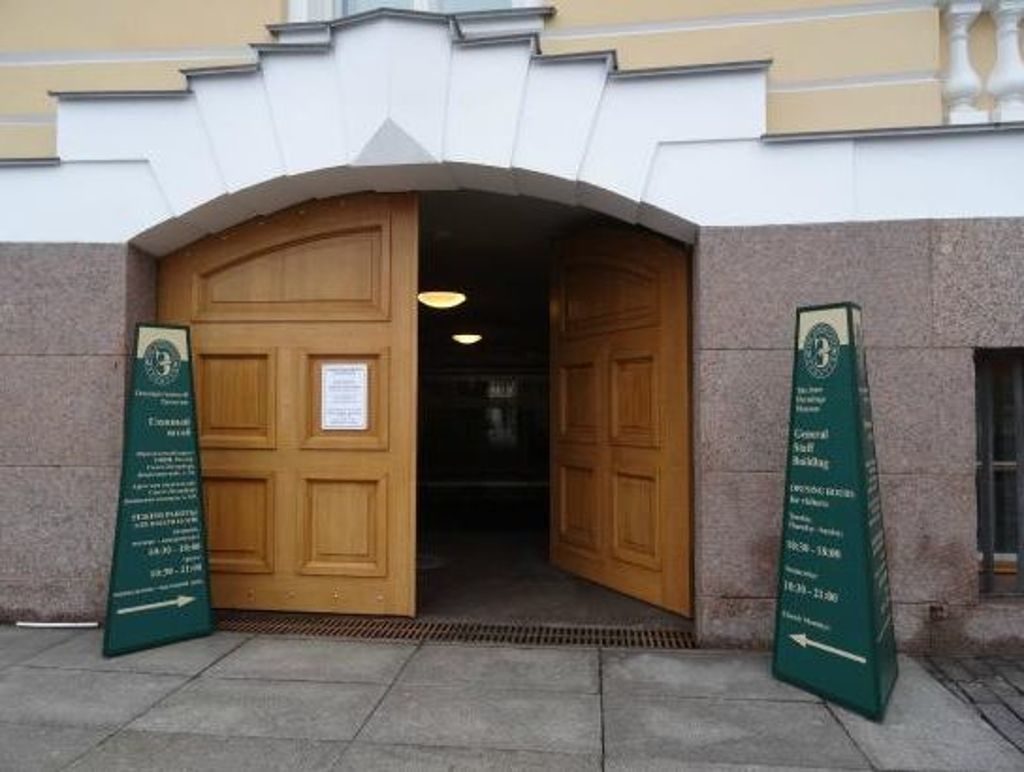 Another notable thing is the huge staircase on the right one can see right after the entrance. There are two such staircases at each end of the Enfilade, made of travertine -a stone frequently used in modern architecture. Here travertine is polished to a smooth shiny finish and resembles marble.
Another notable thing is the huge staircase on the right one can see right after the entrance. There are two such staircases at each end of the Enfilade, made of travertine -a stone frequently used in modern architecture. Here travertine is polished to a smooth shiny finish and resembles marble.
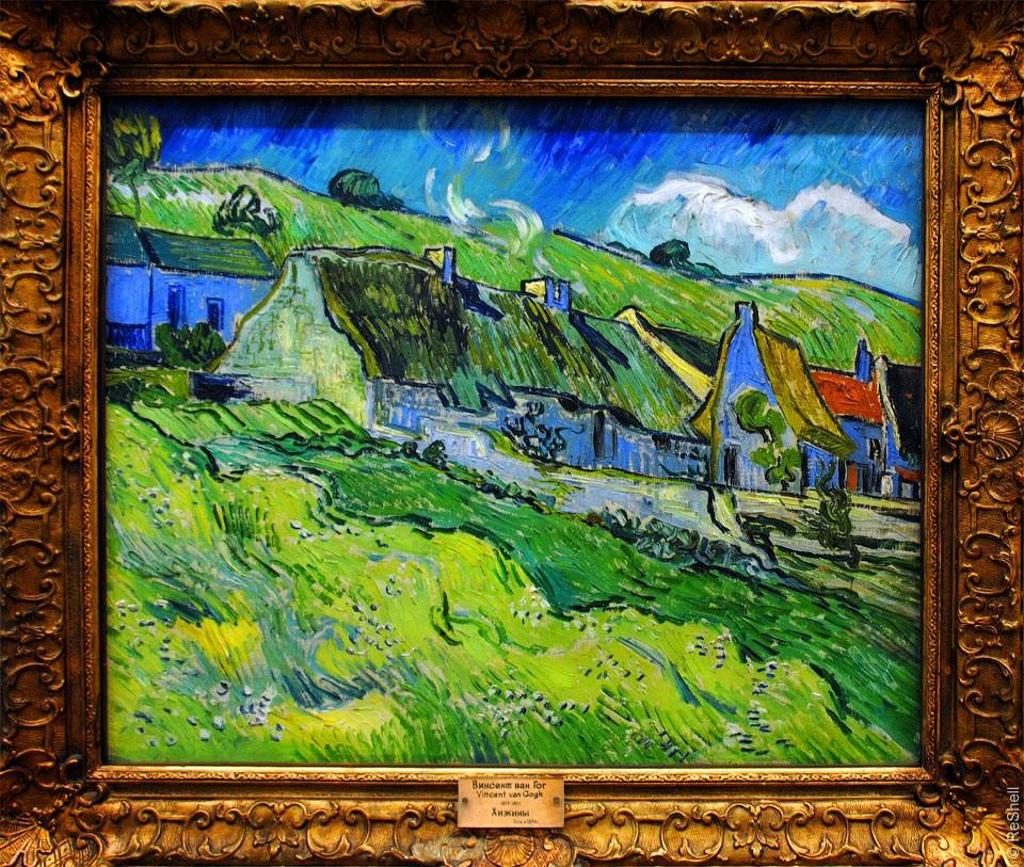 The museum’s second floor houses a permanent display, The Age of Art Nouveau, an amazing collection of gifts to the tsars, and a themed exhibition about the Ministry of Finance of the Russian Empire, once situated in the building.
The museum’s second floor houses a permanent display, The Age of Art Nouveau, an amazing collection of gifts to the tsars, and a themed exhibition about the Ministry of Finance of the Russian Empire, once situated in the building.
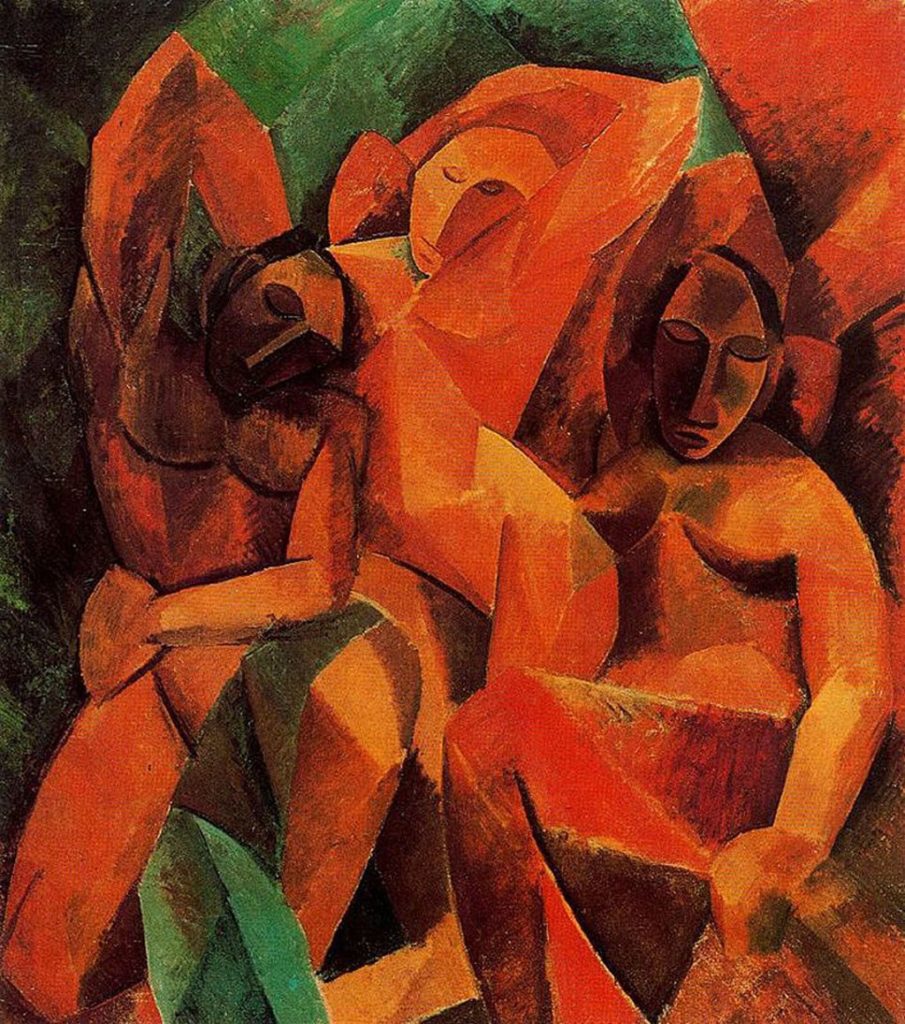 On the third floor are to be found three exhibitions: Under the Sign of the Eagle – The Art of Empire, which offers a comparison of French and Russian decorative art and costume of the age; French Painting and Sculpture of the 19th Century; Western European Art of the 19th Century (from Germany, Holland, Belgium) and the 18th century Russian Guards Museum. Also included on the third floor is a display which follows the history of the Ministry of Foreign Affairs of the Russian Empire, which also used to be an occupant of this part of the General Staff Building.
On the third floor are to be found three exhibitions: Under the Sign of the Eagle – The Art of Empire, which offers a comparison of French and Russian decorative art and costume of the age; French Painting and Sculpture of the 19th Century; Western European Art of the 19th Century (from Germany, Holland, Belgium) and the 18th century Russian Guards Museum. Also included on the third floor is a display which follows the history of the Ministry of Foreign Affairs of the Russian Empire, which also used to be an occupant of this part of the General Staff Building.
General Staff Building St Petersburg
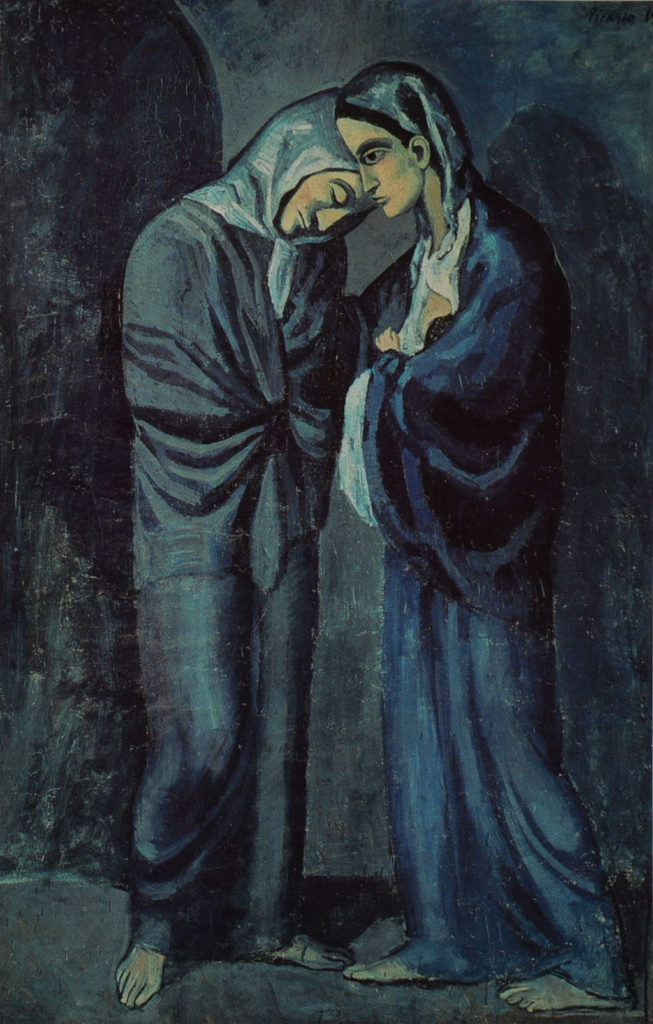 The collection found on the fourth floor is very rich and includes amazing work of art of French impressionists and post-impressionists. You can get here by ascending the staircase or using one of the elevators. It is a place to come back again and again, well worth it, with beautifully hung paintings with plenty of light – from well-known painters. There are benches in almost every room, to sit and quietly study the famous art of the French masters. Here at the General Staff Building, the exhibition area is more spacious and air-conditioned with some rooms sky-lighted with natural light coming through the ceiling.
The collection found on the fourth floor is very rich and includes amazing work of art of French impressionists and post-impressionists. You can get here by ascending the staircase or using one of the elevators. It is a place to come back again and again, well worth it, with beautifully hung paintings with plenty of light – from well-known painters. There are benches in almost every room, to sit and quietly study the famous art of the French masters. Here at the General Staff Building, the exhibition area is more spacious and air-conditioned with some rooms sky-lighted with natural light coming through the ceiling.
 So, here you can find such great names of the French Impressionists and Post Impressionists as Claud Monet, Edgar Degas, Auguste Renoir, Camille Pissarro, Alfred Sisley, Paul Cezanne, Vincent Van Gogh, Paul Gauguin, Maurice Deni, Anri Matisse, Pablo Picasso and many others. The Picasso collection covers his most popular early periods and includes Sisters, from the painter’s Blue Period, and several cubist masterpieces including Three Women (1908) and a stunning Still Life of 1913.
So, here you can find such great names of the French Impressionists and Post Impressionists as Claud Monet, Edgar Degas, Auguste Renoir, Camille Pissarro, Alfred Sisley, Paul Cezanne, Vincent Van Gogh, Paul Gauguin, Maurice Deni, Anri Matisse, Pablo Picasso and many others. The Picasso collection covers his most popular early periods and includes Sisters, from the painter’s Blue Period, and several cubist masterpieces including Three Women (1908) and a stunning Still Life of 1913.
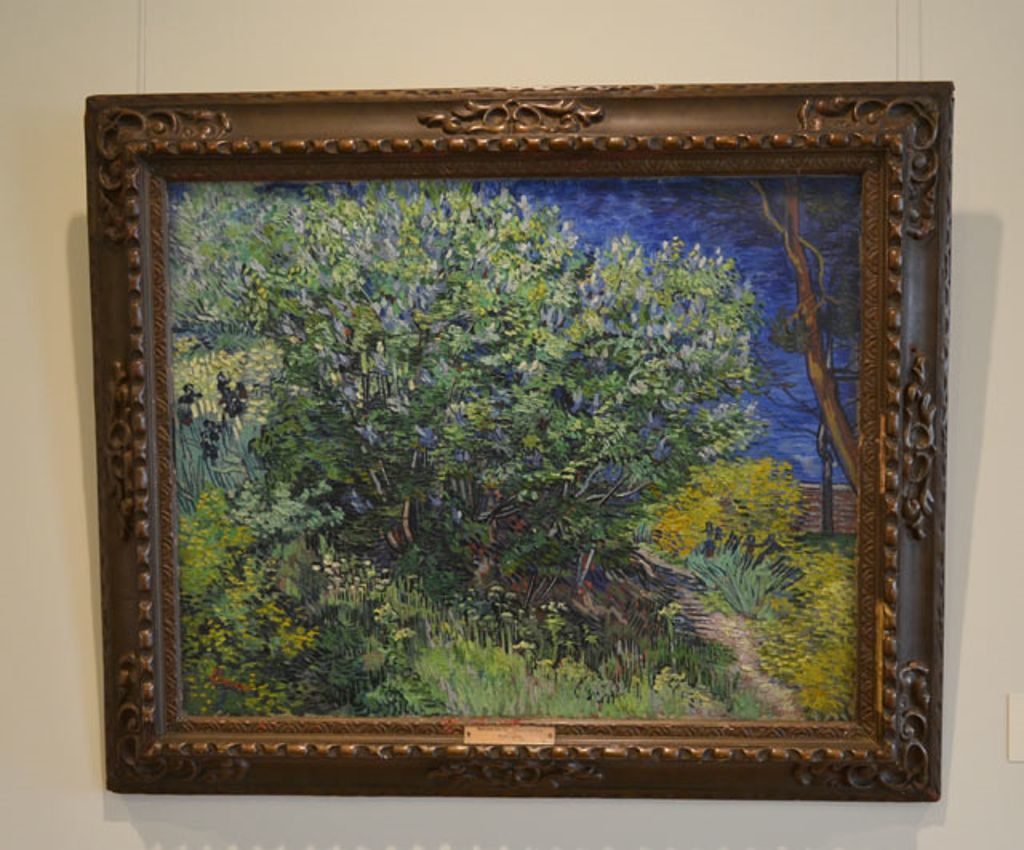
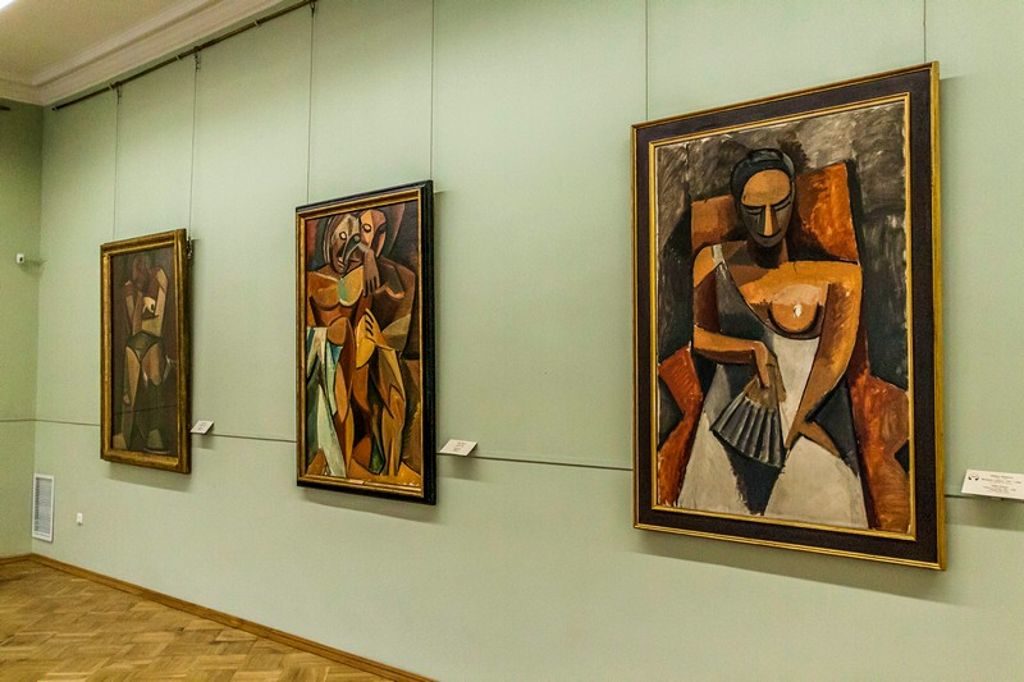 The great legacy of the impressionist and Post-impressionist belonged to the celebrated collections of the Muscovites Sergey Schukin and Ivan Morozov. These collections were nationalized after the Revolution of 1917 and a part of them was later moved to the Hermitage museum. Here, there are also collections of Russian and European artists, decorative paintings and sculptures from the 19th and 20th centuries.
The great legacy of the impressionist and Post-impressionist belonged to the celebrated collections of the Muscovites Sergey Schukin and Ivan Morozov. These collections were nationalized after the Revolution of 1917 and a part of them was later moved to the Hermitage museum. Here, there are also collections of Russian and European artists, decorative paintings and sculptures from the 19th and 20th centuries.
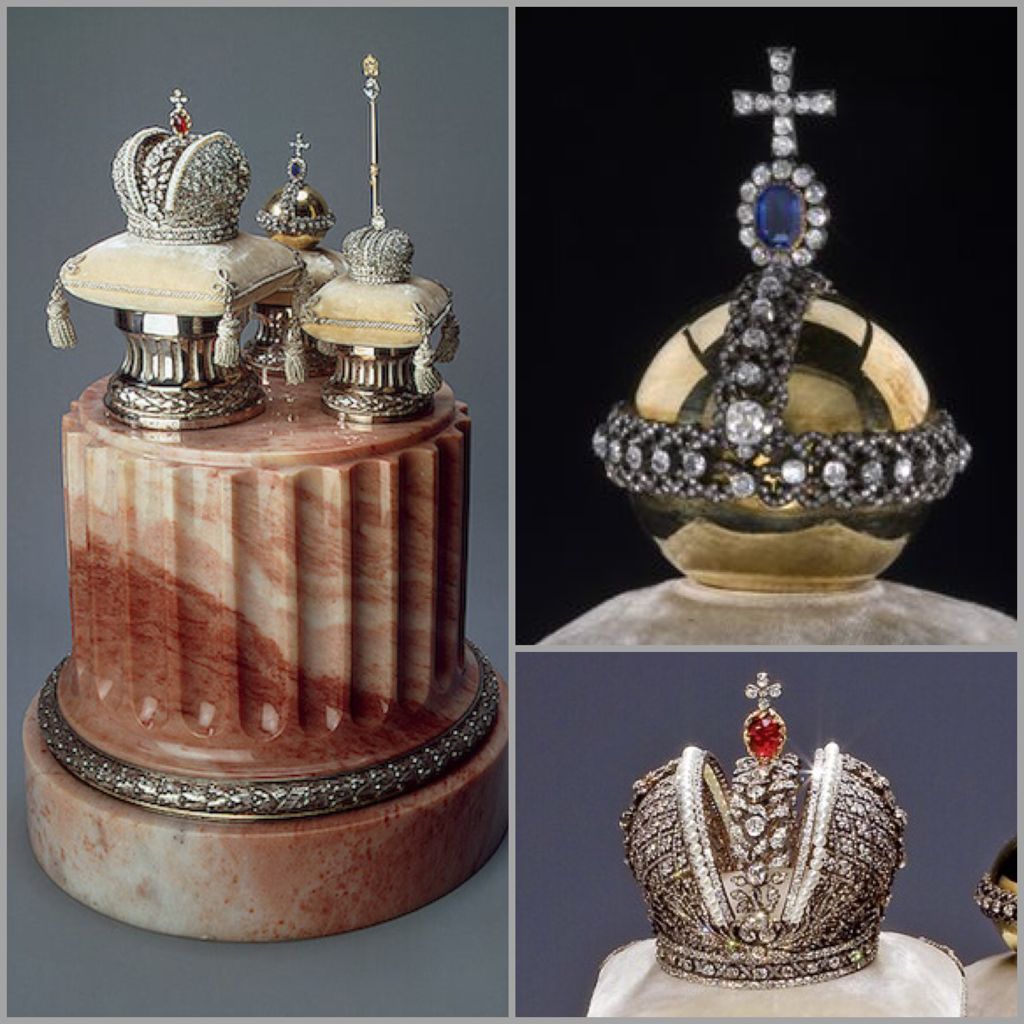 Of great interest in the General Building, are the memorial rooms of Carl Faberge, the famous Russian jeweller of the end of the 19th and early 20th century. The Hermitage displays several formidable masterpieces by Faberge among them are the replica of the Russian Imperial Crown, the presentation dish of rock crystal and decorative bouquets of flowers. Especially notable is the Rothschild clock egg – a gift by the President Vladimir Putin for the Hermitage’s 250th anniversary in 2014. This is the only Easter Egg by Faberge, which is kept in the Hermitage.
Of great interest in the General Building, are the memorial rooms of Carl Faberge, the famous Russian jeweller of the end of the 19th and early 20th century. The Hermitage displays several formidable masterpieces by Faberge among them are the replica of the Russian Imperial Crown, the presentation dish of rock crystal and decorative bouquets of flowers. Especially notable is the Rothschild clock egg – a gift by the President Vladimir Putin for the Hermitage’s 250th anniversary in 2014. This is the only Easter Egg by Faberge, which is kept in the Hermitage.
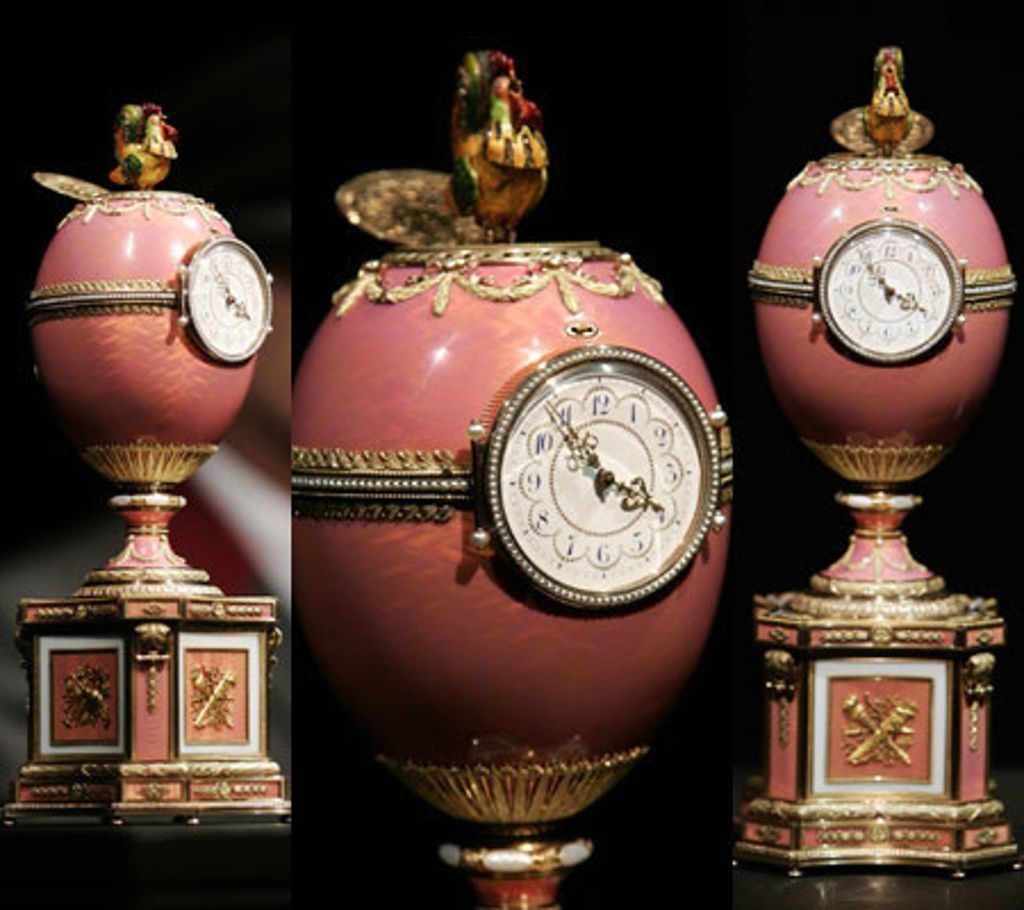 The exhibition also includes the renovated historical interiors of the Ministry of Foreign Affairs of the Russian Empire and the personal apartments of the Chancellor Count Karl Nesselrode.
The exhibition also includes the renovated historical interiors of the Ministry of Foreign Affairs of the Russian Empire and the personal apartments of the Chancellor Count Karl Nesselrode.
Bottom Line
So, as you can judge, a Tour of the General Staff Building St Petersburg will be a very interesting part of your visit to the Hermitage Museum!
| Location: | 6/8, Dvortsovaya Ploshchad |
|---|---|
| Metro: | Admiralteyskaya |
| Telephone: | +7 (812) 333-2655 |
| Opening hours: | Daily from 10.30am to 6 pm (to 9 pm on Wednesdays and Fridays). Closed on Monday. |
| Admission: | RUB 300 (or on the RUB 600 combined ticket with the main museum complex). |
| Photo and video: | Non-flash still photography is permitted. No video. |
| Accessibility: | Wheelchair accessible. |




